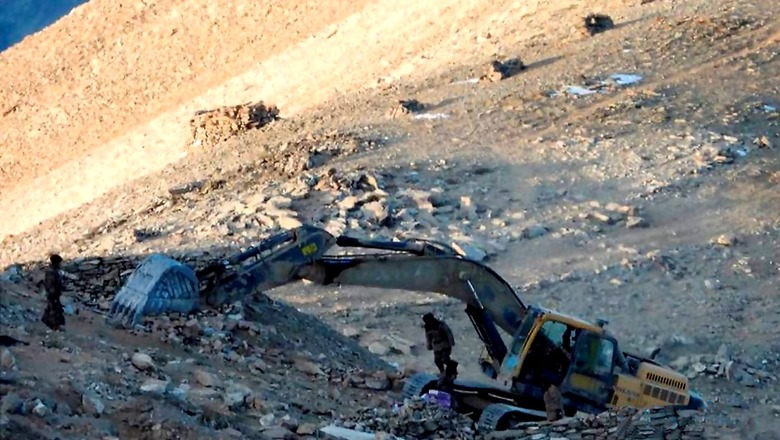
views
The disengagement of Indian and Chinese troops, amassed face to face in the Pangong Tso area in Galwan Valley in Ladakh for the past nine months, comes as a relief not only to the people of India and China but also to the neighbouring Asian states and the world. Though the process of troop withdrawal has taken place only in one sector and talks are still on for disengagement and reduction of tensions in three other areas – Hot Springs-Gogra, Depsang and Demchok– a war that few wanted appears to have been averted.
The withdrawal of Chinese forces, from areas it had recklessly occupied across the Line of Actual Control (LAC) since April 2020, to its post east of Finger 8, indicates a reassessment of tactics by Beijing. The People’s Liberation Army (PLA) with unprecedented alacrity has dismantled all bunkers, structures and tents erected in the area it occupied up to Finger 4 and retreated to the pre-April 2020 position as insisted by India. In the interest of a compromise, India has agreed to withdraw its troops from the Kailash range heights it had captured in August 29-30 that turned the tables and put enormous pressure on the PLA. It has been agreed that till the time the two sides agree on the LAC in the area, neither side will patrol in this vacated region.
The agreement underlines that the Chinese leadership, and the PLA may have begun to appreciate that India is not going to accept wanton Chinese expansion and coercive tactics against its territory, and the diplomatic loss of face and the price of its miscalculation have become unsustainable. Its mission has failed, and new tactics are necessary against India. It has also become clear that India will take all possible action – political, military, diplomatic and economic– to ensure that China does not repeatedly violate the confidence-building and military agreements that it signed with India over a period of 30 years. In 1993, 1996, 2005 and 2012, both sides agreed formally to maintain peace and tranquility along the LAC, delineate the LAC, not to use force and resolve the boundary dispute in a fair manner. These agreements have all been flouted by China. As China’s power has grown, so has its capacity and resolve to advance its strategic and territorial interests. China will prepare for a new offensive elsewhere, on a different plane and field when the time is ripe.
A new protocol to ensure the LAC is clearly defined in Eastern Ladakh and other sensitive areas, and strictly respected by both the sides, has become essential for sustaining peace between India and China. This is something that India has always wanted, and China has so far refused to undertake, even though both sides agreed to do so in 1997. However, it is unlikely to materialise till China sees it to be in its strategic interest. India thus needs to be fully prepared for the military, economic and diplomatic challenges that China is going to pose constantly, and increasingly.
Indeed, notwithstanding how the disengagement and potential de-escalation proceed, the crisis has begun to have large strategic consequences that will define India-China relations in the coming years. Accompanied as it was by China’s escalating rivalry with the United States, an all-round military build-up, and aggressive actions by China in the South China Sea, in the Taiwan Straits, in Hong Kong and against Japan and Australia, Beijing’s Ladakh action has had a major strategic impact. Worse, this all-round aggressive nationalist action astonishingly launched by the Xi Jinping regime came amid an international pandemic attack that not only originated in China itself but Beijing’s secrecy and failure to alert the world in time and sharing full information contributed to its global spread. Few now see China as a trustworthy partner or a responsible global power.
End of a Phase
Bilaterally, China’s unprovoked military action and barbaric attack with barbed clubs on unarmed Indian soldiers in which 20 of them were killed broke all agreements and has deeply scarred the relationship. While there have been several incursions along the LAC in the past few decades, it was the first attack in which Indian soldiers were killed since 1975. The Ladakh showdown has fully revealed, if there were any lingering doubts, China as an expansionist and aggressive power that will continue to pursue its territorial and hegemonic goals as its power grows unless it is thwarted. There is going to be no ‘peaceful rise’ – a theory advanced by Chinese communist party propagandists and intellectual rationalisers in the initial decades of its reforms and growth. Under the overambitious and aggressive nationalist leadership of Xi Jinping, nothing is sacred – not the bilateral agreements it has signed, nor international law such as the Law of the Sea or universal norms not to use force to settle territorial disputes.
The crisis also brings to a close three decades of Indian efforts to improve relations and resolve the territorial dispute by deepening engagement with China. Since 1988, India and China have held regular summits to improve and normalise ties, expanded trade and cultural relations, and India opened its markets to Chinese imports and capital. They held 17 rounds of Joint Working Group talks between 1988 and 2003, followed by 22 rounds of Special Representative meets (between the Indian national security adviser and Chinese vice minister) to resolve the boundary dispute without success. India’s engagement strategy was predicated on the expectation that trust, destroyed by China’s 1962 invasion, would be gradually rebuilt as summits, trade, diplomatic talks, military confidence-building agreements, and working together on multilateral fora such as SCO, BRICS, East Asia Summit, WTO, etc, would lead to trust and a mutually beneficial and stable relationship. That hope has been dashed by China’s latest armed attack, huge military mobilisation and threat of war. Interestingly, the military action came within 6 months of the October 2019 Modi-Xi summit at Mahabalipuram where Xi held forth on peace and cooperation.
The engagement strategy did not work to India’s advantage nor promote mutual gains and reciprocity. China’s economic and military power rapidly expanded through this period, giving it many options to pressurise India. India sustained mounting trade deficits year after year and allowed China to control critical areas of telecommunications, electronics, active pharma ingredients, automobile components and machinery, bulk drugs and drug formulations, automobile and machinery components, boilers, solar cells, electric batteries, etc, even as China kept its market closed to items India could export. Through this period China also strengthened its military ties with Pakistan, constructed the China-Pakistan Economic Corridor through the Pakistan-occupied part of Jammu and Kashmir, unmindful of Indian protests, thwarted Indian and international efforts to ban terror groups operating from Pakistan, and opposed India’s entry into the Nuclear Supply Group and reform of the UN Security Council. Indian policymakers also grievously failed to appreciate the strategic and security impact of growing asymmetry of power that China’s growth, centrality in global supply chains, military build-up, and large investments in high-tech, on India and its bargaining capacity with China. With gains from the relationship heavily tilted in China’s favour, it is still a mystery why Xi Jinping opted to initiate military action in Ladakh. Like all dictatorships without adequate checks and balances on power, China has miscalculated and must suffer the consequences. The happy times are over.
New Dynamics
A long shadow has now fallen on the relationship and a new, more difficult phase marked by strategic competition and expansion of security challenges across the Himalayas, the neighbourhood, and the Indian Ocean has commenced. China’s economic and military growth, advances in the cyber domain and critical new technologies pose mounting threats. In short, India is now forced to focus on its economic growth, defence expenditure, invest heavily in manufacturing and technology, and expand its security relationship with strategic partners. India has taken major steps to boost manufacturing and defence industrialisation through the Atmanirbhar Bharat policy that seeks to end dependence on Chinese imports and make India a manufacturing power. It has also undertaken a series of major economic reforms to boost infrastructure, attract foreign investments, and make India an alternative hub for global supply chains. Punishing China, it has banned over 200 Chinese apps on security grounds, restricted Chinese companies from securing government contracts, and cut back imports in several sectors. India needs to do much more to bridge the power gap with China.
Diplomatically too New Delhi has overcome its remaining hesitations regarding fully embracing the Quad –comprising the US, Japan, Australia, and India – as an essential element of its security policy and a pillar of the emerging Asian order. At the latest Quad foreign ministers’ meeting on February 18 – the first since the Biden administration assumed office in Washington DC – New Delhi underlined its “commitment to upholding a rules-based international order, underpinned by respect for territorial integrity and sovereignty, rule of law, transparency, and freedom of navigation in the international seas and peaceful resolution of disputes”, in an unmistakable reference to China’s conduct in recent years. A new balance of power is emerging in Asia. India will inevitably be part of it and must actively shape it to secure its interests. The Quad, underpinned by the 2+2 dialogues with the partners, growing defence and economic ties with the US, and joint military and naval exercises such as the Malabar, is also committed to diversify global supply chains to reduce dependence on China. It is an opportunity that India cannot afford to miss if it is to balance China and secure its vital interests.
Engagement with China under the new conditions would have to be redefined. Trade and investments would have to be guided by security interests, reciprocity and protecting Indian companies. The dynamics of India’s emerging phase of relationship with China would inevitably be more challenging, complex, and competitive than it has been thus far.
Read all the Latest News, Breaking News and Coronavirus News here




















Comments
0 comment